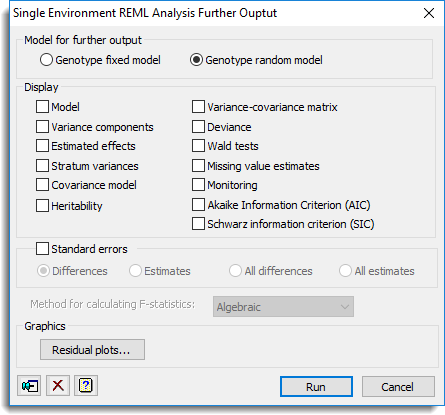Use this to select further output following a preliminary single environment REML analysis.

Model for further output
The preliminary single environment analysis runs a REML analysis twice. In the first analysis the genotypes are used as a random term and in the second analysis they are fitted as a fixed term. This option lets you select further output for either of these REML models.
Display
This specifies which items of output are to be produced by the analysis.
| Model | Description of the model fitted by the analysis |
| Variance components | Estimates of variance parameters |
| Estimated effects | Estimates of regression coefficients |
| Stratum variances | Estimates of approximate stratum variances |
| Covariance model | Estimated covariance models in matrix format |
| Heritability | For the model where the genotype factor is fitted as a random term this displays the measure of heritability |
| Variance-covariance matrix | Variance-covariance matrix for the variance parameters |
| Deviance | The residual deviance |
| Wald tests | Wald Tests for fixed model terms and accompanying F-statistics |
| Missing value estimates | Estimates of missing values |
| Monitoring | Monitoring information at each iteration |
| Akaike information coefficient (AIC) | Akaike information coefficient to assess the random model |
| Schwarz information coefficient (SIC) | Schwarz information coefficient to assess the random model |
Standard Errors
Tables of effects are accompanied by estimates of standard errors. You can choose whether Genstat computes standard errors or standard errors of differences (SEDs) for the tables.
Method for calculating F-statistics
This controls whether Wald tests for fixed effects are accompanied with approximate F statistics and corresponding numbers of residual degrees of freedom. The computations, using the method devised by Kenward & Roger (1997), can be time consuming with large or complicated models. So, the default setting automatic, can be used to allow Genstat to assess the model itself and decide automatically whether to do the computations and which method to use. The other settings allow you to control what to do yourself:
| none | No F statistics are produced |
| algebraic | F statistics are calculated using algebraic derivatives (which may involve large matrix calculations) |
| numerical | F statistics are calculated using numerical derivatives (which require an extra evaluation of the mixed model equations for every variance parameter). |
Graphics
The residual plots button can be used to generate plots of residuals. For the spatial models use the Display variogram button to display the residuals in a variogram.
Action Icons
| Pin | Controls whether to keep the dialog open when you click Run. When the pin is up |
|
| Clear | Clear all fields and list boxes. | |
| Help | Open the Help topic for this dialog. |
See also
- REML directive for mixed model analysis in command mode